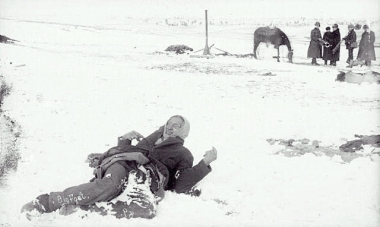
- Details
- By Levi Rickert
One hundred and thirty-two winters ago, on December 29, 1890, some 150 Lakota men, women and children were massacred by the US 7th Cavalry Regiment near Wounded Knee Creek on the Pine Ridge Indian Reservation. Some estimate the actual number closer to 300.
 Make A Donation Here
Make A Donation Here
Snowfall was heavy that December week. The Lakota ancestors killed that day were left in brutal frigid wintry plains of the reservation before a burial party came to bury them in one mass grave. The photograph of Big Foot’s frozen and contorted body is a symbol for all American Indians of what happened to our ancestors.
Some of those who survived were eventually taken to the Episcopal mission in Pine Ridge. Eventually, some of them were able to give an oral history of what happened.
One poignant fact of the massacre has remained in my mind since first reading it. Every time I think about Wounded Knee, I remember this:
"It was the fourth day after Christmas in the Year of our Lord 1890, when the first torn and bleeding bodies were carried into the candlelit church, those who were conscious could see Christmas greenery hanging from the open rafters across the chancel front above the pulpit was strung a crudely lettered banner: Peace on Earth, Good Will to Men," writes Dee Brown in Bury My Heart at Wounded Knee.
Want more Native News? Get the free daily newsletter today.
There was no peace on earth for the Lakota four days after Christmas.
Later, as absurd as it may sound, some 20 US Cavalry soldiers were given the Medal of Honor – for killing innocent Lakota men, women and children. What an insult to those who lost their lives. What an insult to humanity.
Rightfully so, there is a movement afoot to strip those soliders of their medals. Hopefully, Congress will see fit to pass the Remove the Stain Act in 2023. They must.
The Wounded Knee Massacre is a symbol for all American Indians of what happened to our ancestors.
History records the Wounded Knee Massacre was the last battle of the American Indian Wars. Unfortunately, it is when most American history books drop American Indians from history, as well. As if we no longer exist.
Fortunately, American Indians have survived – one generation after another – since Wounded Knee. It is for us who remain to remember our ancestors as we make for a better life for those we encounter today. We are also taught to prepare for the next seven generations, but as we do, we must remember our ancestors.
We remember those ancestors lost 132 winters ago on December 29.
More Stories Like This
Native News Weekly (August 25, 2024): D.C. BriefsUS Presidents in Their Own Words Concerning American Indians
Indigenous Actor Elaine Miles Reports Detention by Alleged ICE Agents
Happy Thanksgiving from Native News Online
Coming Up on Native Bidaské: Behind the Animation: Joey Clift Talks “Pow” and Native Storytelling
Help us tell the stories that could save Native languages and food traditions
At a critical moment for Indian Country, Native News Online is embarking on our most ambitious reporting project yet: "Cultivating Culture," a three-year investigation into two forces shaping Native community survival—food sovereignty and language revitalization.
The devastating impact of COVID-19 accelerated the loss of Native elders and with them, irreplaceable cultural knowledge. Yet across tribal communities, innovative leaders are fighting back, reclaiming traditional food systems and breathing new life into Native languages. These aren't just cultural preservation efforts—they're powerful pathways to community health, healing, and resilience.
Our dedicated reporting team will spend three years documenting these stories through on-the-ground reporting in 18 tribal communities, producing over 200 in-depth stories, 18 podcast episodes, and multimedia content that amplifies Indigenous voices. We'll show policymakers, funders, and allies how cultural restoration directly impacts physical and mental wellness while celebrating successful models of sovereignty and self-determination.
This isn't corporate media parachuting into Indian Country for a quick story. This is sustained, relationship-based journalism by Native reporters who understand these communities. It's "Warrior Journalism"—fearless reporting that serves the 5.5 million readers who depend on us for news that mainstream media often ignores.
We need your help right now. While we've secured partial funding, we're still $450,000 short of our three-year budget. Our immediate goal is $25,000 this month to keep this critical work moving forward—funding reporter salaries, travel to remote communities, photography, and the deep reporting these stories deserve.
Every dollar directly supports Indigenous journalists telling Indigenous stories. Whether it's $5 or $50, your contribution ensures these vital narratives of resilience, innovation, and hope don't disappear into silence.
 The stakes couldn't be higher. Native languages are being lost at an alarming rate. Food insecurity plagues many tribal communities. But solutions are emerging, and these stories need to be told.
The stakes couldn't be higher. Native languages are being lost at an alarming rate. Food insecurity plagues many tribal communities. But solutions are emerging, and these stories need to be told.
Support independent Native journalism. Fund the stories that matter.
Levi Rickert (Potawatomi), Editor & Publisher

